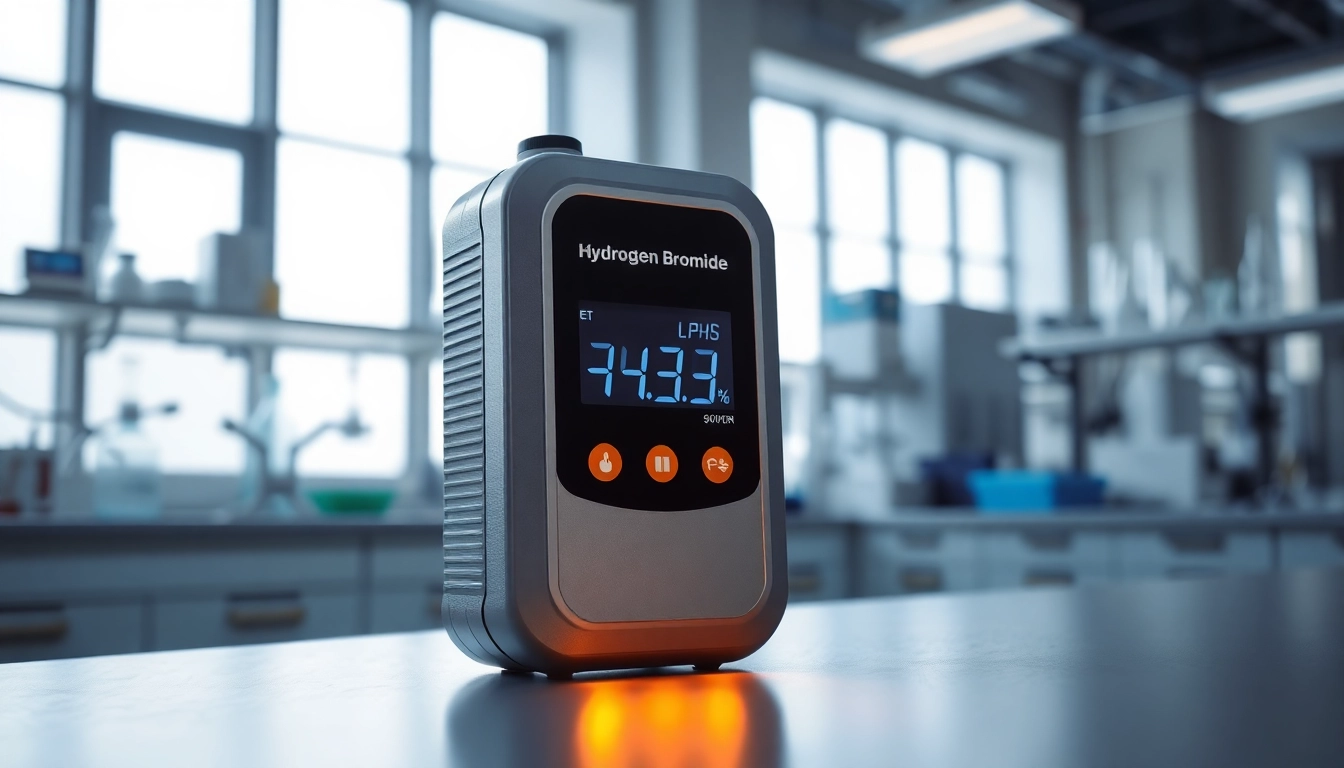Understanding Hydrogen Bromide: Risks and Properties
What is Hydrogen Bromide?
Hydrogen bromide (HBr) is a colorless gas at room temperature with a strong, pungent odor. It is highly soluble in water, forming hydrobromic acid, which is a strong acid utilized in various industrial applications, including the production of bromine, as a catalyst in organic syntheses, and in etching glass. Given its widespread use, understanding the risks associated with hydrogen bromide and ensuring safe handling through proper detection methods is crucial. Industrial environments often require a Hydrogen Bromide gas detector to monitor levels and prevent potential health hazards.
Health Risks Associated with Hydrogen Bromide
Exposure to hydrogen bromide poses significant health risks. When inhaled, it can cause severe respiratory issues, including coughing, choking, and inflammation of the respiratory tract. Short-term exposure can result in irritation of the eyes and skin, along with potential damage to lung tissues. Moreover, prolonged or high-concentration exposure can lead to more severe health complications, such as pulmonary edema or other long-term respiratory problems. Therefore, it’s essential for facilities that utilize or produce hydrogen bromide to implement strict safety measures, including adequate ventilation and continuous monitoring with reliable gas detection equipment.
Physical Properties of Hydrogen Bromide
Hydrogen bromide is characterized by several distinct physical properties that contribute to its hazardous nature. It has a molecular weight of 80.91 g/mol and a boiling point of -66.8 °C. At room temperature, it exists as a gas but can easily transition into a liquid under pressure or in a colder environment. The gas has a density of 3.64 g/L, making it heavier than air, which means it can accumulate in low-lying areas. Understanding these properties is critical for designing safety protocols and utilizing detection systems effectively.
Choosing the Right Hydrogen Bromide Gas Detector
Key Features to Look For
Selecting an appropriate hydrogen bromide gas detector involves evaluating several crucial features. The detector should have rapid response times, allowing for quick identification of potentially dangerous gas levels. Look for instruments that provide real-time readings and alerts, ensuring timely intervention when exposure levels exceed safe thresholds. Additionally, portability can be a key factor for on-site assessments, while various calibration options should be available to maintain precise readings over time.
Types of Sensors and Their Effectiveness
There are various sensor technologies available for detecting hydrogen bromide, with each having its advantages and limitations. Electrochemical sensors are commonly utilized for their sensitivity and specificity towards hydrogen bromide, providing reliable readings at low concentration levels. Another option includes photoionization detectors (PIDs), which can detect a broader range of volatile organic compounds, making them adaptable for multi-gas monitoring. However, it’s essential to assess the specific operational requirements and the potential interferences when choosing a gas sensor technology.
Understanding Detection Ranges and Sensitivities
The effectiveness of a hydrogen bromide gas detector is heavily influenced by its detection range and sensitivity. Ideally, the detector should operate effectively at low parts-per-million (ppm) levels, as hydrogen bromide can have harmful effects at concentrations that are not immediately perceptible. It’s advisable to opt for detectors that allow customization of alarm settings to account for different chemical process requirements, enhancing the safety protocols in place.
Proper Installation and Maintenance of Gas Detectors
Steps for Installing Your Hydrogen Bromide Detector
To ensure optimal functionality, proper installation of hydrogen bromide detectors is paramount. Start by selecting strategic locations for mounting the detectors where HBr accumulations could potentially occur—in areas near storage tanks, processing equipment, or shipping/receiving zones. Follow manufacturer guidelines closely; placement height should be in accordance with the gas’s density characteristics. After mounting, conduct initial calibration tests to ensure the detector is reading correctly before initiating regular operations.
Routine Maintenance Checklist
Regular maintenance is essential for gas detector reliability. Create a checklist that includes the following routine tasks:
- Regularly calibrate the sensors according to manufacturers’ recommendations.
- Test operational readiness by simulating gas exposure.
- Inspect the detector and its mounting for physical damage.
- Check battery levels and replace if necessary to avoid downtime.
- Log all maintenance activities for record-keeping and compliance purposes.
Keeping a detailed maintenance schedule not only promotes device longevity but also enhances workplace safety.
Common Installation Mistakes to Avoid
While installing hydrogen bromide gas detectors, several common mistakes can diminish effectiveness. Ensure detectors are not placed in areas with poor airflow, as stagnant air can lead to inaccurate readings. Avoid mounting devices near equipment that emits excessive heat or vibration, as these can interfere with sensor accuracy. Finally, do not overlook the significance of environmental conditions, such as humidity, which can impact the sensor’s operation. Attention to these details can significantly improve the reliability of detection systems.
Regulatory Compliance and Safety Standards
Understanding OSHA and EPA Regulations
Occupational Safety and Health Administration (OSHA) and Environmental Protection Agency (EPA) regulations are critical for the safe handling of hazardous gases, including hydrogen bromide. OSHA outlines permissible exposure limits (PEL) to ensure worker safety, while the EPA manages environmental exposure through stringent guidelines. Compliance with these regulations entails adopting proper gas detection measures and ensuring that workplaces adhere to safety protocols to mitigate health risks.
Documentation Required for Compliance
Documentation plays a vital role in demonstrating compliance with regulatory standards. Maintain records of regular safety audits, calibration activities, and training sessions for personnel who work with hydrogen bromide. Documentation of material safety data sheets (MSDS) for hydrogen bromide and detailed incident reports can further enhance compliance readiness. Regular updates to these documents are paramount to ensure they reflect current practices and regulatory changes.
Impact of Non-Compliance on Health and Safety
Failure to comply with established regulations regarding hydrogen bromide can have dire consequences. Non-compliance not only puts workers at risk of exposure but also can lead to significant legal ramifications and financial penalties for organizations. Moreover, the reputation of the company may suffer irreparably if safety incidents occur. By emphasizing compliance and regularly reviewing safety protocols, organizations can safeguard both employee health and operational integrity.
Case Studies: Effective Use of Hydrogen Bromide Detectors
Industry-Specific Applications
The use of hydrogen bromide detectors can vary widely across different industries, from chemical manufacturing to pharmaceutical production. In one case study from a chemical manufacturing facility, the implementation of real-time monitoring systems for hydrogen bromide has reduced exposure incidents by over 40%. Similarly, in the pharmaceutical industry, detectors have been utilized to prevent contamination of production environments, showcasing the versatile applications of these detectors in maintaining safety standards.
Lessons Learned from Real-World Scenarios
Real-world implementations provide valuable lessons in the deployment of hydrogen bromide detection systems. For example, one facility experienced repeated false alarms, which were traced back to oversensitivity of the detectors. By re-calibrating and adjusting sensor thresholds, the facility enhanced reliability and reduced unnecessary panic among personnel. These insights demonstrate the importance of continuous evaluation and adjustment in detector systems to align with operational needs.
Future Developments in Gas Detection Technology
The future of hydrogen bromide detection technology looks promising with advancements in sensor accuracy, miniaturization, and integration with broader safety systems. Emerging technologies such as IoT-enabled devices allow for enhanced data collection and real-time monitoring across multiple sites. This evolution presents significant opportunities for creating comprehensive safety networks that bolster both health and regulatory compliance across various industries.



